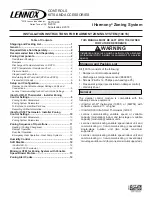
SS-SVX11K-EN
95
The oil in the vacuum pump should be changed each
time the pump is used with a high quality vacuum
pump oil. Before using any oil, check the oil container
for discoloration which usually indicates moisture in
the oil and/or water droplets. Moisture in the oil adds to
what the pump has to remove from the system, making
the pump inefficient.
When connecting the vacuum pump to a refrigeration
system, it is important to manifold the vacuum pump
to both the high and low side of the system (liquid line
access valve and suction line access valve). Follow
pump manufacturer’s directions for proper methods of
using vacuum pump.
The lines used to connect pump to the system should
be copper and the largest diameter that can practically
be used. Using larger line sizes with minimum flow
resistance can significantly reduce evacuation time.
Rubber or synthetic hoses are not recommended for
system evacuation. They have moisture absorbing
characteristics which result in excessive rates of
evaporation, causing pressure rise during standing
vacuum test. This makes it impossible to determine if
system has a leak, excessive residual moisture, or a
continual or high rate of pressure increase due to
hoses.
An electronic micron vacuum gauge should be
installed in the common line ahead of the vacuum
pump shutoff valve, as shown in
[Either the href or the
keyref attribute should be set on xref elements]
Figure 32, p. 51
. Close Valves B and C, and open Valve
A.
Start vacuum pump. After several minutes, the gauge
reading will indicate the maximum vacuum the pump
is capable of pulling. Rotary pumps should produce
vacuums of 100 microns or less.
Open Valves B and C. Evacuate the system to a
pressure of 300 microns or less. As vacuum is being
pulled on the system, it may appear that no further
vacuum is being obtained, yet the pressure is high. To
facilitate the evacuation process, it is recommended
that the vacuum be “Broken”.
To break the vacuum, close valves A, B, & C and
connect a refrigerant cylinder to the charging port on
the manifold. Purge the air from the hose. Raise the
standing vacuum pressure in the system to “zero” (0
psig) gauge pressure. Repeat this process two or three
times during evacuation.
N
No
otte
e:: It is unlawful to release refrigerant into the
atmosphere. When service procedures require
working with refrigerants, the service technician
must comply with all Federal, State, and local
laws.
Standing Vacuum Test
Once 300 microns or less is obtained, close Valve A and
leave valves B and C open. This will allow the vacuum
gauge to read the actual system pressure. Let the
system equalize for approximately 15 minutes. This is
referred to as a “standing vacuum test” where, time
versus pressure rise. The maximum allowable rise over
a 15 minute period is 200 microns. If the pressure rise is
greater than 200 microns but levels off to a constant
value, excessive moisture is present. If the pressure
steadily continues to rise, a leak is indicated.
illustrates three possible results of the “standing
vacuum test”.
If a leak is encounter, repair the system and repeat the
evacuation process until the recommended vacuum is
obtained. Once the system has been evacuated, break
the vacuum with refrigerant, and complete the
remaining “Pre-Start Procedures” before starting the
unit.
Figure 67.
Typical vacuum pump hookup
Manifold
Valve C
Valve B
Vacuum Gauge
Valve A
Vacuum
Pump
To System
High Side
To System
Low Side
Содержание RAUJ-C20
Страница 6: ...6 SS SVX11K EN Wiring Diagrams 128 T Ta ab bl le e o of f C Co on nt te en nt ts s...
Страница 117: ...SS SVX11K EN 117 S St ta ar rt t U Up p...
Страница 129: ...SS SVX11K EN 129 N No ot te es s...
Страница 130: ...130 SS SVX11K EN N No ot te es s...
Страница 131: ...SS SVX11K EN 131 N No ot te es s...
















































